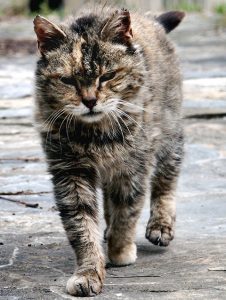CKD means Chronic Kidney Disease – it’s also known as kidney failure and chronic renal failure. It is a progressive condition causing the cat’s kidneys to gradually stop working. 
What do a cat’s kidneys do?
The kidneys have four main functions.
Firstly, they regulate the cat’s water and salt balance. If the cat is dehydrated, they retain water – producing smaller amounts of more concentrated urine – whereas if they have drunk too much, the kidneys produce larger volumes of more dilute urine. At the same time, they control the amounts of various salts in the cat’s blood – sodium, potassium, calcium, phosphate and others.
They also have a vital role in getting rid of waste products. The most important are urea (a breakdown product from protein in the diet) and creatinine (a waste product produced by the muscles). These chemical wastes are actively concentrated in the cat’s urine.
As well as water balance, the kidneys also help to regulate blood pressure, via a cascade of enzymes in the blood that cause the blood vessels to constrict (raising the pressure) or dilate (dropping it).
Finally, they help to control the numbers of red blood cells in the blood by releasing a hormone called erythropoietin (of cycling cheat fame!) which tells the bone marrow to make more.
What causes CKD?
There is a range of possible causes, including damage to the kidneys by infections or toxins; tumours in the kidneys; and some birth defects. There is also a genetic condition called polycystic kidney disease (PKD), where kidney tissue is progressively replaced with large fluid-filled cysts (it’s most common in Persians and related breeds).
However, in most cases, the cause is far simpler – degeneration due to old age and a high protein diet. As obligate carnivores, cats need a lot of protein in their diet to survive, but this means the kidneys have to work harder to remove the breakdown products than the kidneys of herbivores such as horses – so chronic, long-term damage is much more common.
Fortunately, there is a great deal of functional reserve – a cat can survive perfectly well if only ? of their kidney tissue is working properly. As a result, CKD is rarely seen in young cats – it is probably developing, but until ? of their kidney volume has failed, there won’t be any symptoms.
What cats are at risk?
All cats – some estimates suggest that as many as half of all cats who reach 15 years old have clinical CKD. Even really well cared for pets – and big cats like lions in zoos – are at the same risk.
OK, so what are the symptoms?
The symptoms are usually subtle and vague to begin with, but get gradually worse with time as more of the kidney tissue fails and more waste products build up in the blood. Typical signs include:
- Increased production of dilute urine; this may cause incontinence.
- Increased thirst
- Dehydration
- Weight loss
- Poor coat quality
- Loss of appetite
- Lethargy
- Muscle weakness (due to salt imbalances in the blood stopping the muscles from working properly – usually low potassium levels)
- Vomiting (due to the build-up of toxins)
- Bad breath (often it smells metallic, as blood urea levels rise)
- Seizures, collapse and death will eventually follow
Cats may also develop anaemia (causing pale gums and shortness of breath) and high blood pressure (which can cause blindness or strokes).
How is CKD diagnosed?
CKD is usually diagnosed with a combination of blood tests and urine tests. We do blood tests to look for increased urea, creatinine and, sometimes, a newly discovered marker for kidney function called SDMA. Elevated levels suggest kidney disease.
The most important urine test we can do is the urine specific gravity, which tells us how well the kidneys are concentrating the cat’s urine. A normal cat should have a specific gravity of over 1.035, whereas a CKD cat often has a value well below this. In addition, protein in the urine can sometimes be a marker of kidney problems.
We’ll use these same parameters to monitor their progression, as well as regular blood pressure checks.
How can it be treated?
CKD in cats cannot be cured. However, it can be managed, with changes in lifestyle, diet, and medications.
Cats with CKD have higher than normal water requirements, so making sure they always have access to fresh water is vital. Some cats don’t like to drink still water, so there are a variety of water fountains available for them!
A specialist renal diet is really important – these are specially formulated to support the kidney’s function (less phosphate and protein, to reduce the kidney’s workload, and more potassium). However, not all cats accept these diets; if not, a phosphate binding agent and (sometimes) supplemental potassium must be added to their normal food.
The mainstays of drug treatment in CKD are medications to reduce protein leakage out of the damaged kidneys, and control blood pressure. ACE inhibitors (like benazepril) and a new drug telmisartan are most commonly used because these have both effects. Sometimes, medication specifically to reduce blood pressure (such as amlodipine) is also needed.
What about transplants?
At the moment, it is illegal to carry out kidney transplants in cats in the UK because of concerns over the welfare of the donor cats, and worries about the risks of establishing a black market in feline organs.
However, cats with CKD can survive for many months or even years with appropriate care and treatment.
If you think your cat may be showing signs of kidney disease, make an appointment to see one of our vets as soon as possible. Early diagnosis makes treatment much more effective!
